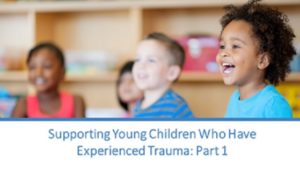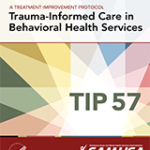 A resource collection compiled by and for Parent Centers.
A resource collection compiled by and for Parent Centers.Coordinated by the Region 2 Parent Technical Assistance Center @ ECAC
September 2018
The contents of this web page will connect Parent Centers, families, and others with: (a) the basic principles that define trauma-informed care (TIC); (b) the most relevant websites to consult; (c) videos and webinars that focus specifically on TIC; and (d) resources on how to become a trauma-informed care organization. We’ve divided the resources by their FOCUS for easier reference, as follows:
- What is Trauma-Informed Care?
- Websites to Explore
- Videos and Webinars
- On Becoming a Trauma-Informed Organization
This web page of resources is one part of the larger Resource Collection on Trauma-Informed Care, a mini-library put together through a collaboration of RPTAC 2 @ ECAC, CPIR, and a review and development team of Parent Center staff.
What is Trauma-Informed Care?
5 Ways Trauma-Informed Care Supports Children’s Development
Short article from Child Trends discussing…
- what child trauma is
- how many children are estimated to be affected,
- five ways that being informed about trauma can help adults support children’s healthy development.
https://www.childtrends.org/publications/5-ways-trauma-informed-care-supports-childrens-development
Brief introduction to SAMHSA’s six key principles of a trauma-informed approach to address trauma’s consequences and facilitate healing. https://www.samhsa.gov/nctic/trauma-interventions
This 17-page guide will definitely help organizations to develop a working concept of trauma and a trauma-informed approach, as well as a shared understanding what would be acceptable and appropriate across an array of service systems and stakeholder groups. The guide:
- is grounded in research
- goes over the 6 principles of a trauma-informed approach
- describes 10 key implementation domains (e.g., governance and leadership, staff development)
- gives sample questions to consider when implementing a trauma-informed approach.
http://www.traumainformedcareproject.org/resources/SAMHSA%20TIC.pdf
Training curriculum from SAMHSA
- Introduces trauma and trauma-informed approaches in behavioral health and human services
- Moves slide by slide, showing a thumbnail image of the slide and offering talking points that trainers can adapt to fit the needs of their audience
Download the slideshow and its trainer manual: Slideshow in PDF | Trainer Manual
Helping Traumatized Children: A Brief Overview for Caregivers
17 pages long, from the ChildTrauma Academy
- begins with frequently asked questions (e.g., “Should I talk about the event?”)
- flows into a section called How Can I Help? that gives 9 basic suggestions
- moves on to Special Considerations for Traumatized Infants (“Can infants recall a traumatic experience later in life?”)
- concludes with Key Points: Helping Traumatized Infants and a glossary
https://www.childtrauma.org/_files/ugd/aa51c7_237459a7e16b4b7e9d2c4837c908eefe.pdf
Online resource from the Center for Child Trauma Assessment, Services and Interventions Describes:
- what trauma-focused therapy is
- SAMHSA’s definition of a trauma-focused therapy
- benefits
- trauma-focused treatment activities
- types of trauma-focused treatments
- How Do I Know if a Therapist is Trauma-Informed?
http://cctasi.northwestern.edu/family/trauma-focused-therapy/

Trauma-informed care is
a strengths-based service
delivery approach…
…that is grounded in an understanding of and
responsiveness to
the impact of trauma;
…that emphasizes physical, psychological, and emotional safety for both providers and survivors;
…that creates opportunities
for survivors to rebuild
a sense of control and empowerment.
Hopper, Bassuk, & Olivet, 2010
Websites to Explore
Be sure to visit these websites, which focus on trauma-informed care from the perspective of professionals addressing the needs of individuals who have experienced trauma, either recently or in the past. Please note that websites specific to trauma in children, adverse childhood experiences, and how parents can help their children cope with traumatic events are listed separately–on the Basic Information about Trauma page.
Trauma Informed Care Project (TIC)
As the name makes clear, the project is all about trauma informed care, which it describes as an organizational structure and treatment framework that involves understanding, recognizing, and responding to the effects of all types of trauma. The project is based in Iowa, but its materials will be helpful to organizations and families everywhere. Parent Centers will especially appreciate the wide variety of family-oriented and school-oriented tools available under the “Resources–Publications” menu.
Center for Child Trauma Assessment, Services and Interventions (CCTASI)
The Center provides national expertise on interventions for the developmental effects of trauma across child-serving settings, including child welfare, behavioral health, educational, and juvenile justice settings. In addition to producing films such as Remembering Trauma (see below, under Videos and Webinars) and developing assessment and screening toolkits and training materials for front-line professionals, the Center offers a wealth of information directed at families, youth, and caregivers.
National Center on Trauma Informed Care and Alternatives to Seclusion and Restraint (NCTIC)
NCTIC works to eliminate the use of seclusion, restraints, and other coercive practices and to develop the knowledge base on trauma-informed care. NCTIC is a program of SAMHSA, the Substance Abuse and Mental Health Services Administration. It provides training and technical assistance to a range of service systems (e.g., community-based behavioral health agencies; domestic violence organizations; and state and federal agencies). Parent Centers may find NCTIC’s website most helpful in terms of its many links to the resources of other federal agencies and within SAMHSA itself–such as the Behavioral Health Treatment Services Locator, Suicide Prevention Hotlines, and the Disaster Distress Hotline.
https://www.samhsa.gov/nctic

Videos and Webinars
Supporting Young Children Who Have Experienced Trauma | Webinar 1
This 1-hour webinar comes from the Community of Practice (CoP) for Children with High Needs. You can download the webinar (and its slides) or simply play it back online. It comes with a very handy list to the right of each slide and its timing, which allows you to skip past all the early housekeeping details and hop straight to key parts, such as:
- Slide 4 (purpose of the webinar);
- the 2nd listing of Slide 7 (the baggage many children bring into care settings);
- Slide 8 (the 3 E’s of trauma);
- Slide 9 (types of trauma);
- Slide 10 (how trauma affects all aspects of life);
- Slide 11 (the ACE study);
- Slides 12-13 (graphics from various studies on longer-term effects;
- Slide 14 (why do I need to understand trauma?);
- Slides 15-18 (trauma in young children);
- Slides 19-21 (brain development);
- Slide 22 (body response);
- Slides 23-32 (impact of trauma on various ages);
- Slides 33-34 (what it means to be trauma informed);
- Slides 35-41 (sneak peak into the next webinar in this series).
Access the webinar at: https://www.youtube.com/watch?v=hLI2bhh-AU4
Remembering Trauma is a 16-minute film highlighting the graphic life of a traumatized youth from his early childhood into older adolescence. The film illustrates the impact of complex trauma and the potential for misdiagnosis across various service systems.
DISCLAIMER: This film is inspired by a true story. This story shows the various ways that trauma can impact youth. It contains adult language and includes scenes with family violence and sexual assault, which may be upsetting to watch. It is strongly recommended that children or youth viewing this film do so in the presence of a trusted adult who can offer support as needed.
Access the video at: https://www.youtube.com/watch?v=v13XamSYGBk
______________
Remembering Trauma Part 2
Part 2 is 32 minutes long and incorporates scenes from the narrative Part 1 film, with poignant commentary from real world professionals who work across child-serving settings, including school, juvenile justice and mental health.
https://www.youtube.com/watch?v=l27l-wZ5a1c

On Becoming a Trauma-Informed Organization
The process of becoming a trauma-informed organization requires a multi-year organizational commitment. Given that, the descriptions of resources below are a bit more detailed than others offered in this resource collection. We want you to have a good IDEA of what each resource contains and the relative depth of the guidance it offers. Some resources will give you the “general idea” of what you need to do as an organization, while others will give you a step-by-step, indepth process to adapt and follow.
__________
From the National Council for Behavioral Health
This detailed slideshow is a good resource for Parent Center leadership to consult in building their own organization’s capacities. It includes:
- basic information about trauma, its causes, prevalence, and costs;
- an interesting and useful section called “What Hurts and What Helps” from service providers (told from a consumer perspective);
- trauma-informed care principles and the 7 domains that organizations need to put in place to create a trauma-informed organization (e.g., screening processes, creating a safe and secure environment);
- “Lessons from the Field.”
 Walking the Walk: Modeling Trauma Informed Practice in the Training Environment
Walking the Walk: Modeling Trauma Informed Practice in the Training Environment
From Multiplying Connections
This 2-pager succinctly captures the essence of what’s needed for an organization to become trauma-informed. One of the key components is professional development. It is not enough, however, to just “inform” professionals about trauma in an effort to build a trauma-informed workforce. In the process of providing professional development and workforce training, it is essential that organizations and trainers embed and model principles of trauma-informed practice in the training environment. Good food for thought, if you’re among the trainers or decision makers.
 This TIP (Treatment Improvement Protocol) from SAMHSA is quite extensive, but its various chapters and suggested strategies are easy to access individually. It delves into:
This TIP (Treatment Improvement Protocol) from SAMHSA is quite extensive, but its various chapters and suggested strategies are easy to access individually. It delves into:
- trauma causes
- understanding its impact
- screening and assessment
- trauma-specific services
- how to implement a plan for becoming a trauma-informed organization
- how to build a trauma-informed workforce.
- Valuable tools (consumer materials, organizational assessments) can be found in the appendices.
Access the TIP at: https://www.ncbi.nlm.nih.gov/books/NBK207201/
This self-assessment is intended to be a tool to help organizations assess their readiness to implement a trauma-informed approach. Honest and candid staff responses can help the organization identify opportunities for program and environmental change, assist in professional development planning, and can be used to inform organizational policy change.
http://www.traumainformedcareproject.org/resources/Trauam%20Informed%20Organizational%20Survey_9_13.pdf
 This is the “mapping tool/self-assessment” for individuals that focuses on their knowledge, skills, and capacity (core competencies) around trauma. For example, a person’s degree of knowledge, skills, or values about specific areas such as “understands impact of trauma across the life-span” could be assessed as (a) “Demonstrates competency”; (b) “Needs further development”; or (c) “Little to No Exposure.”
This is the “mapping tool/self-assessment” for individuals that focuses on their knowledge, skills, and capacity (core competencies) around trauma. For example, a person’s degree of knowledge, skills, or values about specific areas such as “understands impact of trauma across the life-span” could be assessed as (a) “Demonstrates competency”; (b) “Needs further development”; or (c) “Little to No Exposure.”The tool also includes a section where organizations can assess the degree to which they are creating conditions in which the people they serve feel safe and comfortable, their privacy protected, and their individual needs accommodated. The ending section of the mapping tool provides a Trauma-Informed Action Plan worksheet for staff and teams to use in creating their own needed actions and responsibilities.
https://www.parentcenterhub.org/wp-content/uploads/2017/11/Trauma-Materials.pdf
This 7-page assessment list from the Traumatic Stress Institute begins by stating that “the process of implementing trauma-informed care generally takes multiple years. While implementation of these elements is the goal, the list represents an ideal to strive for.” Therefore, the assessment is meant to be comprehensive. Not all areas of self-assessment will necessarily apply to Parent Centers, but most will, including
- Trauma-Informed Care Values
- Administrative Support for Program-wide Trauma-Informed Services
- Organizational Structure
- Trauma Screening and Assessment
- Physical Environment and Layout of Agency
- Restraint and Seclusion Reduction
- Workforce Development
- Staff Trauma Training
- Monitoring Trauma-Informed Care Initiatives
Access the organizational self-assessment at:
https://traumaticstressinstitute.org/wp-content/uploads/2010/06/Trauma-Informed-Care-Org-Self-Assessment-Final.pdf
What It Takes
“Becoming a trauma‐informed organization requires a system‐wide change in culture. Time‐limited trainings, training clinicians in an evidence‐based practice, or restraint reduction will NOT, by themselves, make an organization trauma‐informed. Becoming trauma‐informed usually requires a multi‐year initiative involving mandated staff training, broad administrative buy‐in, policy changes, and persistent reinforcement by TIC champions in the organization.”
Which part of this Resource Collection would you like to visit now?
Return to the Resource Collection landing page
Resource Collection | Basic Information about Trauma
Resource Collection | What is Trauma-Informed Care? (You’re already here)
Resource Collection | Trauma and Specific Populations
Resource Collection | Building Trauma-Informed Schools
Resource Collection | Responding to Disasters

